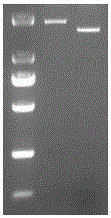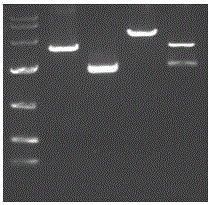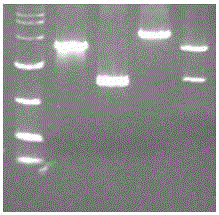Preparation method of H7N9 pseudoviruses and applications of H7N9 pseudoviruses
A pseudovirus, avian influenza virus technology, applied in the field of biomedicine, can solve problems such as high mortality and restricting the research and development of H7N9 avian influenza
- Summary
- Abstract
- Description
- Claims
- Application Information
AI Technical Summary
Problems solved by technology
Method used
Image
Examples
Embodiment 1
[0040] Example 1: Construction of pVAX-HA and pVAX-NA vectors
[0041] 1. Obtain the nucleotide sequence of HA (439507) and NA (439509) genes of H7N9 / A / Anhui / 1 / 2013 (EPI_ISL_138739) strain from GISAID;
[0042] 2. Optimize the HA and NA gene sequences according to the principles of mammalian cell codon optimization, and add HindIII and BamHI restriction endonuclease sites at the 5'and 3'of the sequence. The optimized sequence is made by Kings Swiss synthesis; wherein the optimized sequence of the H7N9 hemagglutinin protein gene (HA) mammalian expression codon is shown in SEQ ID NO. 1, and the optimized sequence of the H7N9 neuraminidase gene (NA) mammalian expression codon is shown in SEQ ID NO. 2. Show.
[0043] 3. Double enzyme digestion of pVAX-1 vector with BamHI and HindIII, and recovery of vector fragments;
[0044] 4. Mix the HA and NA fragments with the linearized vector at a molar ratio of 1:5, and ligate with T4 ligase at 16°C for 12 hours
[0045] 5. Transform DH5α competen...
Embodiment 2
[0049] Example 2: pVAX-TMPRSS2 vector construction
[0050] 1. Obtain the nucleotide sequence of TMPRSS2 (BC_051839) gene from NCBI;
[0051] 2. Design primers based on the TMPRSS2 gene sequence, and add a homologous sequence of pVAX-1 vector to the 5'ends of the upstream and downstream primers;
[0052]
[0053] Note: the underlined part is the homologous sequence of the vector
[0054] 3. Extract RNA from Calu-3 cells and reverse transcription to obtain cDNA;
[0055] 4. Amplify TMPRSS2 by PCR, the PCR reaction conditions are: 94°C, 2min; 94°C, 30s, 58°C, 30s, 72°C, 2min, 35 cycles; 72°C, 10min;
[0056] 5. Double digestion of pVAX-1 vector with BamHI and HindIII, and recovery of vector fragments;
[0057] 6. Mix 20ng of PCR product and linearization vector pVAX-160ng, 2×SeamLessMasterMix, add water to make up to 10μL, react and ligate at 50℃ for 15min, and place on ice;
[0058] 7. Take 5μL of connecting solution and add 50μL of just thawed DH5α competent cells, mix gently, and ice bath...
Embodiment 3
[0064] Example 3: H7N9 pseudovirus packaging scheme one
[0065] 1. Inoculate 4×10 in a 6-well plate 5 293T cells, cultured to 80% confluence;
[0066] 2. Mix the plasmid pNL-4.3.luc.ER- and pVAX-HA according to 3:1 (unit: μg), add 64μL solutionB (transfection reagent components, transfection reagents provided by Shenzhen Angran Biotech Co., Ltd.) and mix to obtain solution1 ;
[0067] 3. Mix 128μLsolutionB and 64μLsolutionA (transfection reagent components, transfection reagents provided by Zhenanran Biological Company) to obtain solution2;
[0068] 4. Add solution2 dropwise to solution1, gently blow and mix, and let stand at room temperature for 30 minutes;
[0069] 5. Add the DNA-liposome complex dropwise to the 293T cell culture medium and incubate at 37°C;
[0070] 6. Discard the culture medium after 5 hours, wash the cells once with PBS, and replace with fresh Opti-DMEM culture medium containing 0.5 μg / ml of bacterial neuraminidase;
[0071] 7. Continue to incubate for 48 hours, ha...
PUM
 Login to View More
Login to View More Abstract
Description
Claims
Application Information
 Login to View More
Login to View More - R&D
- Intellectual Property
- Life Sciences
- Materials
- Tech Scout
- Unparalleled Data Quality
- Higher Quality Content
- 60% Fewer Hallucinations
Browse by: Latest US Patents, China's latest patents, Technical Efficacy Thesaurus, Application Domain, Technology Topic, Popular Technical Reports.
© 2025 PatSnap. All rights reserved.Legal|Privacy policy|Modern Slavery Act Transparency Statement|Sitemap|About US| Contact US: help@patsnap.com



